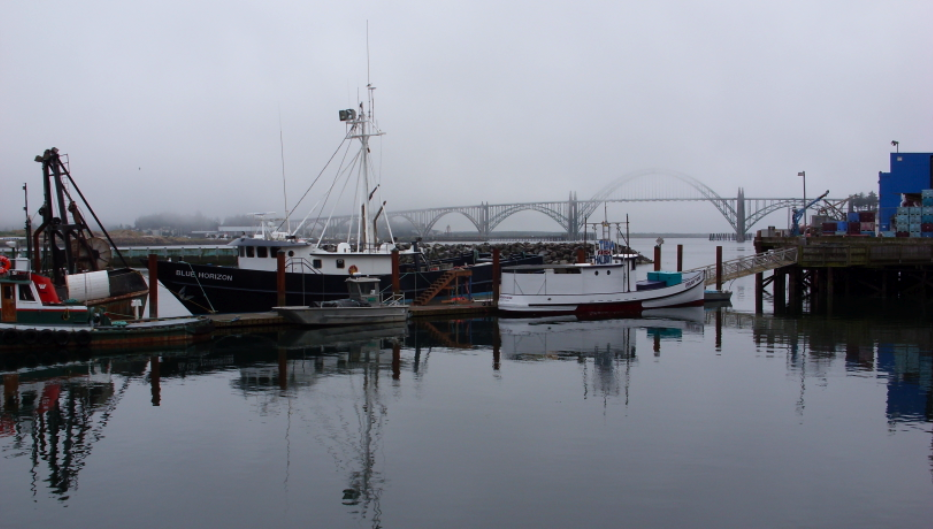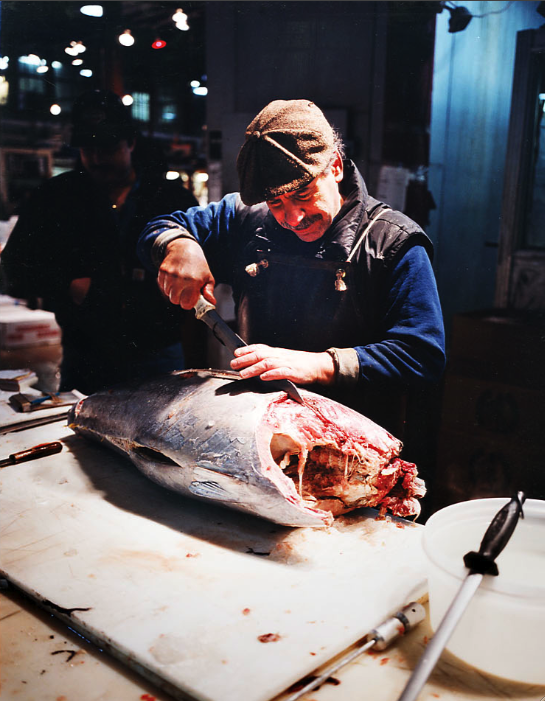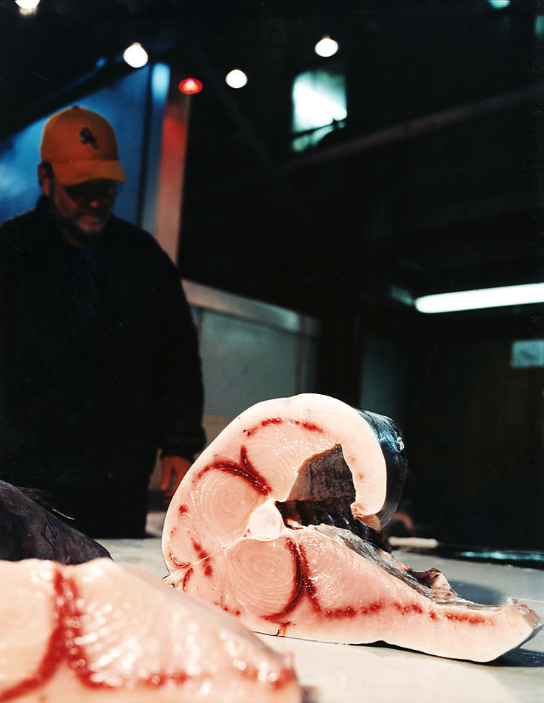
In rough, grey Pacific waters off the rocky Oregon coast, the fishing vessel FV Joanne stalks a school of wild salmon. On board the vessel, Captain Paul Merz patrols the murky ocean depths, anticipating a catch that could eventually help save an endangered species. As the fisherman carefully brings in long lines of fish and releases them from hooks one by one, he removes small samples of the flesh. He then jots down the geographical location of the vessel, the air temperature, and the seawater salinity – oceanographic information that will be sent to a marine science center along with the salmon samples. Within 48 hours, scientists will have access to the genetic data of fish caught during this expedition. The information gathered by Captain Merz will help scientists make management decisions that could determine the fate of entire populations of fish.
Counter to the popular public perception of the fishing industry as one that exploits with an intensity that cannot be sustained, many fishermen and members of fishing communities are actively working to preserve the future of fish and the fishing trade. They’re conducting research alongside scientists, inventing selective nets, setting aside parts of the ocean as protected areas free from fishing, and educating the public about which fish are the best to consume. During travels that extended from the East to West coasts of the United States, I met with members of preservation-oriented fishing communities, including four innovators who are playing leading roles in the effort to protect fish and the world’s oceans.
CHARLESTON, OR-
Late one afternoon in July, I met Captain Merz in front of his stilted, white house in Charleston. Wringing his grease-stained hands, Captain Merz took a break from engine repairs to talk about his fight for the survival of wild Pacific salmon. He said that he hoped that his efforts to restore wild salmon populations will give his son a chance to earning a living wage in the fishing industry. As we discussed his recent research endeavors, Captain Merz leaned one arm against his red pickup truck, a baseball hat with the words “Project CROOS” shadowing his tanned face, his eyes shining and red-rimmed with exhausted intensity. During the past few years, Captain Merz used his fishing vessel more for scientific research than for salmon fishing.
Captain Merz is a leader among a group of 500 fishermen who collect samples of salmon for genetic testing. The effort is a part of an Oregon State University research initiative called “Project CROOS”, an acronym for “Collaborative Research on Oregon Ocean Salmon”. Beginning in 2006, Project CROOS provided equipment and training for fishermen along the US West Coast to collect samples of fish for genetic testing. The genetic data collected by fishermen informs scientists about the origin of different fish populations that come from distinct rivers in Washington, Oregon and California. Some of these rivers are host to healthy fish populations while other rivers yield salmon populations that are diminishing in number each year.
Once salmon migrate from the rivers to the Pacific Ocean, it is impossible to visually distinguish “healthy-population” salmon from at-risk salmon that originate from diminishing populations. Genetic testing allows fishermen to identify the salmon populations that are acceptable to catch and to identify which populations should be left alone. This reprieve may give unhealthy populations a change to recover. Thus, efforts by fishermen involved with Project CROOS are contributing to the recovery of endangered Pacific salmon populations along America’s West coast. These fishers are giving fish a future, and perhaps allowing other young fishermen futures in fishing.

NEWPORT, OR –
The office of Foulweather Trawl, an association of thirty fishermen’s wives in Newport, Oregon, is housed in a weathered edifice that leans slightly towards the water. After ascending a set of creaky stairs, I entered a small room where I met Sara, a net-maker and fishermen’s wife who has over twenty years of experience designing, constructing and mending fishing nets for fishermen in Newport. She is also the inventor of an innovative commercial-scale trawl net that may save the lives of millions of fish: the “Pineapple Trawl”. With her invention Sara has made fishing more sustainable for bottom trawl fishermen.
Normally, commercial bottom trawling is one of the most environmentally destructive forms of fishing. Regular bottom trawl nets drag across the ocean floor and entangle catch many species that cannot legally be sold because of their small size or endangered status. About a third of the fish brought up by regular trawl nets are thrown back overboard, often dead. However, the Pineapple Trawl net prevents the unnecessary death of many fish in a simple yet ingenious way.
A few years ago, scientists proposed a contest to net-builders with the goal of limiting the number of endangered rockfish species caught. Scientists hoped that bottom trawling could be made more sustainable by altering the way the net moves through the water. A regular bottom trawl rolls along the ocean floor on weighted rubber wheels, opening up to form a net shaped like a sideways winter ski hat. The net catches fish that live near and at the bottom of the ocean. In response to the contest, Sara designed the Pineapple Trawl net: an upside-down version of a regular net with a feature that allows for fish swimming at shallower depths to escape. The net excludes many rockfish, which normally swim slightly above the ocean floor. Instead of capturing endangered rockfish, the Pineapple Trawl net instead catches mainly bottom-dwelling flatfish species, which are abundant in the area and safe for sale and consumption.
Why the name “Pineapple Trawl”?
“Pineapple upside-down cake!” Sara said with a laugh. Like a pineapple upside-down cake, which is flipped before serving, Sara’s invention is like an upside-down version of a regular bottom trawl net. She mentioned that many scientists, most not originally from the Newport area, are often baffled by the name. Since the invention of the net, she and other fishermen’s wives have baked pineapple upside-down cakes to share with their new, and very appreciative, scientist friends.
PORT CLYDE, ME-
Jessica is the daughter of a local fisherman, Glen Libby, and head of sales and marketing for Port Clyde Fresh Catch. The company sells locally caught fish on a per-share basis, and educates local communities about fishing and the marine environment. By catching only certain species of fish that that are abundant and over a certain size, fishermen who participate in Port Clyde Fresh Catch are able to market their fish at premiums based on quality and sustainability, rather than on quantity.
A few years ago, fishermen in Port Clyde noticed that they were pulling up fewer fish in their nets. Instead of scrambling to buy bigger boats to keep up with the large commercial vessels, which were sucking up huge numbers of fish and threatening small fishermen with bankruptcy, certain Port Clyde fishermen adopted the idea that “less is more.” In collaboration with the Island Institute, a not-for-profit environmental and community development organization based in Rockland, Maine, fishermen in Port Clyde formed the Midcoast Fishermen’s Association. These fishermen started using special fishing gear that reduces the number of unwanted fish species caught in their nets. Fishermen in the association are committed to fishing sustainably, limiting themselves to catching only species that are abundant in the area and not at risk of endangerment.
In order to be able to sell high quality seafood at a reasonable price, Port Clyde Fresh Catch sells fish, shrimp and lobster directly to customers in pre-paid shares similar to the popular Community Supported Agriculture (CSA) model. In a few short years, Port Clyde Fresh Catch expanded to sell seafood to hundreds of customers along the East Coast while maintaining their commitment to sustainable fishing. Jessica Libby now runs the most successful Community Supported Fishery in the country. All of their operations are run from a tiny, whitewashed old oyster farm on the tip of a peninsula in Port Clyde. Local community members are employed to clean, package and seal all the seafood to be sold at local farmer’s markets and through the Community Supported Fishery share program. Jessica is an integral part of a family and community effort to preserve the future of fish on the Atlantic Coast and to advocate for small-scale commercial fishing practices that are selective, and thus sustainable.

PORT ORFORD, OR-
Recently, a group of fishermen and community members in Port Orford, a small yet active port town south of Charleston, won the National Oceanic and Atmospheric Administration’s prestigious Award of Excellence for Non-Governmental Organization of the Year for 2010-2011. Leesa Cobb, another fisherman’s wife, founded the Port Orford Ocean Resource Team (POORT) with a group of five commercial fishermen and community advocates to protect Port Orford’s ocean resources. The group won the award of excellence for voluntarily establishing areas of the ocean that won’t be touched by fishing nets, in order to protect fish into the future. These marine protected areas serve as nurseries for juvenile fish, and their existence greatly increases the number of fish that will be found in the region into the future.
Upon my arrival, the inside of Leesa’s office was packed from wall to wall with papers and tables and chairs . In a corner of the room, a worn freezer brimmed with fresh seafood caught by a cooperative of Port Orford fishermen. Local residents of Port Orford buy fresh fish for a good price from Leesa and the profits go directly to the fishermen in the cooperative. As Leesa and I spoke, a few young assistants typed diligently behind outdated computer monitors. They were writing recommendations for revisions to commercial fishing standards and policies. Scientists develop standards by interpreting research that allows them to estimate the total number of fish that are currently in the ocean. Based on these estimates, scientists can figure out the number of fish that fishermen should be able to catch, sustainably, without depleting fish stocks in the future. In the management scheme that governs Port Orford’s fisheries, this total allowable catch is broken up into a limited number of shares that fishermen are given, or can buy, in the form of fishing permits.
Current policies allocate fishing permits to fishermen based on how many fish they’ve caught in the past. The more fish a fisherman caught last year, the more permits they’re given for the next year. This gives large fishing vessels an advantage and makes it virtually impossible for new fishermen to enter the industry. Such policies reward big catches and thus encourage over-fishing, ignoring efforts taken to fish more sustainably by catching fewer fish of better quality. By setting aside protected areas and fishing in only designated areas, fishermen in Port Orford are voluntarily fishing less. Leesa and her team are working on policies that insure that they don’t lose their share of permits in the future just because they’ve already been taking measures to protect fish in the present. The success of the community stewardship area in Port Orford is an example for other fishing communities to follow, showcasing the results of collaborative efforts that lead to the empowerment of fishing communities to protect their futures by being stewards of the ocean.
ILWACO, WA
The success of sustainability initiatives taken by fishermen and members of fishing communities will help preserve the future of fish, allowing fishermen to keep fishing a part of their livelihoods and fishing communities to maintain their identities. The success of these initiatives will depend on consumers that recognize the long-term value of buying fish from sustainable sources. I decided to sample some fish caught by local fishermen at the end of my trip up the coast of the Pacific Northwest.
Upon arriving at the southernmost tip of the state of Washington, I stopped at a fish market in the small port town of Ilwaco. Cloaked in sheaths of mist, fishermen unloaded their catch of the day onto the dock behind the Ilwaco Fish Company. Inside the fish market, the floors were slick with seawater, and the fish in the display case looked as if they jumped out of the ocean and landed directly onto the piles of crushed, white ice. A whiteboard was scrawled with the words “Fresh Albacore tuna, caught today.” This was the freshest fish that I’d had access to since hooking a small bass in northern Minnesota ten years ago. The albacore was flavored by the stories of the fishermen I’d met during my travels: tales of persistence amidst challenge and an honest desire to protect the very species that they depend on for their livelihoods, not just for themselves but for future fishermen.
– Featured photo by Rich Press